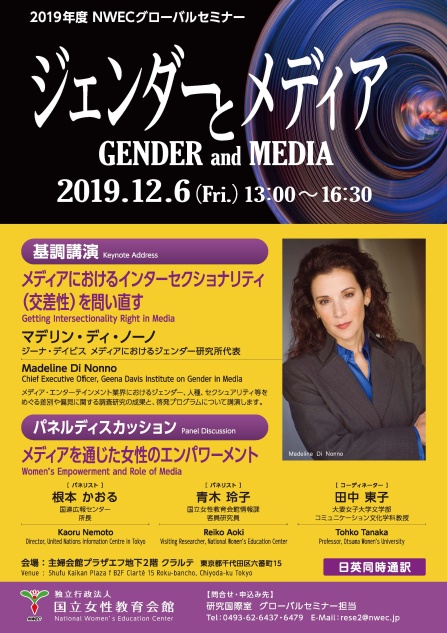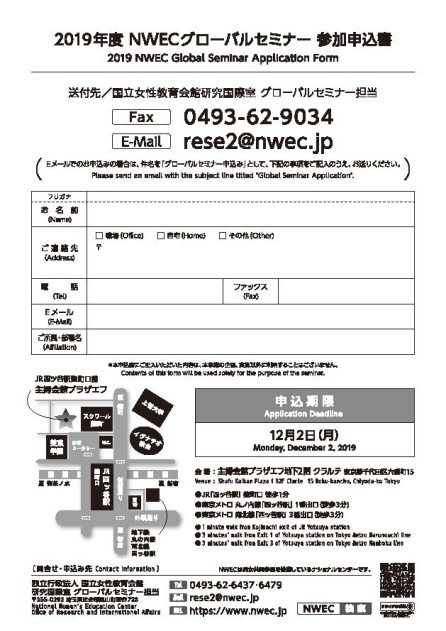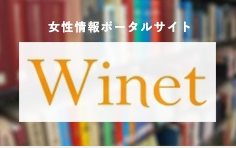International Cooperation
- HOME
- International Cooperation
- NWEC Global Seminar
- FY2019 NWEC Global Seminar: Gender and Media
NWEC Global Seminar
- Event Report
-
FY2019 NWEC Global Seminar: Gender and Media
Date:December 6th, 2019
Place:Shufu Kaikan Plaza f B2F Clarte /
On Friday, December 6th, 2019, the National Women’s Education Center of Japan hosted the 2019 NWEC Global Seminar under the theme of “Gender and Media” at Shufu Kaikan Plaza f (Chiyoda-ku, Tokyo), where active discussions among over 100 participants from home and abroad took place.
Part 1 Keynote Speech
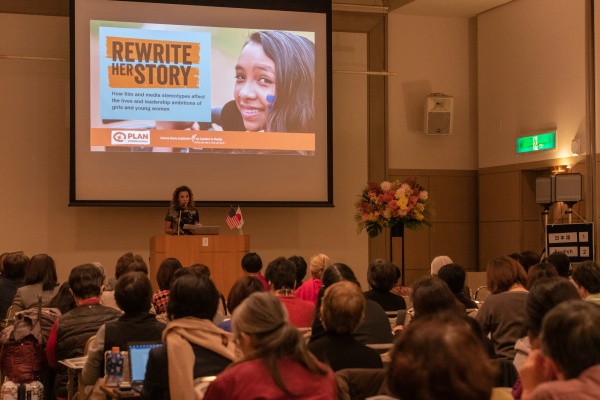
The keynote speaker for Part I, Ms. Madeline Di Nonno, the Chief Executive Officer, Geena Davis Institute on Gender in Media (headquartered in Los Angeles), gave a comprehensively detailed report entitled “Getting Intersectionality Right in Media.”
Geena Davis Institute on Gender in Media is a non-profit organization established by actor Ms. Geena Davis in 2004, and it is the only entity in the media entertainment industry that bases their action on data-driven research and study.
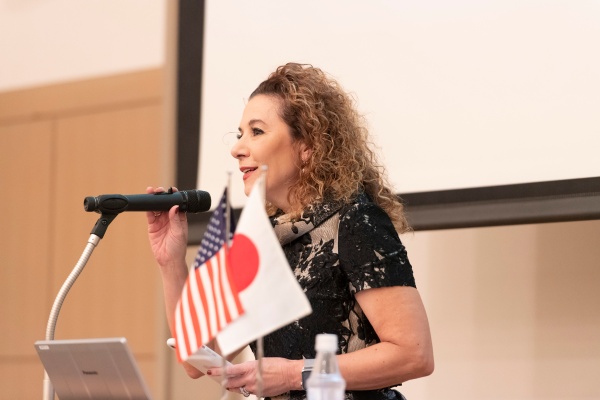 Part I Keynote Address (Ms. Madeline Di Nonno)
Part I Keynote Address (Ms. Madeline Di Nonno)
At the beginning of the keynote address, Ms. Nonno said that media exerts a massive influence on our set of values, and pointed out that women are bereft of an opportunity to make an appearance in entertainment and media, referring to an example that the male-to-female ratio of characters are 2 to 1 despite the fact that 51% of the population is female. She reported on the present situation where media consumption by children engaging with media for more than 7 hours a day makes a substantial impact on their mental health, resulting in a 52% increase in major depression in adolescents. She also pointed out that sexualization of women in media lead to eating disorders, low self-esteem, and depression among girls.
In order to improve the present situation, Ms. Nonno mentioned that it is possible to generate positive influence by correcting on-screen portrayals, showing the results of an in-depth research on gender gap in characters, how female characters are shown as leaders, descriptions of races and disabilities, and so on. She also indicated that the box-office data shows that female led movies do well at the box office, and that family movies with white/people of color co-leads rank at the top of the box-office chart; the box-office performance of movies with white leads is 7.8 billion yen on average while that of with white/people of color co-leads movies is 25.4 billion yen on average. Based on these results, she suggested that introducing gender and diversity perspectives to media and entertainment areas leads to a way to overcome the present situation. Concrete ways for that end include adding specific information to briefs, scripts and casting; replacing first names of male characters by female first names; including races, sexual orientation, disabilities, and so on.
She posed questions such as “Does the female character have agency?”, “Are they hypersexualized?”, “Do they have a sense of humor?” and so on, and ended her speech with specific recommendations including adoption of story writers and directors with diversified backgrounds, equal distribution of marketing resources, stories that reflect experiences of the broader population, and diversification of minor characters.
Part II Panel Discussion
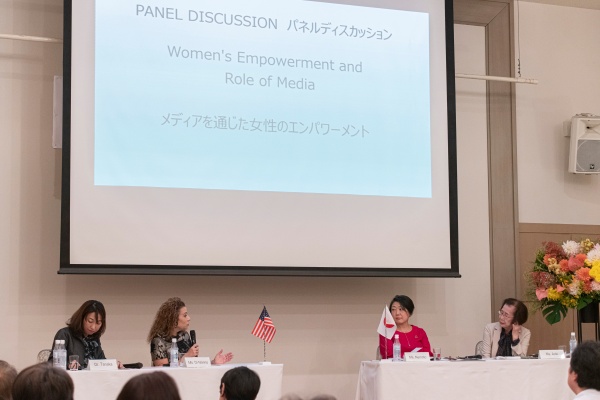 Part II Panel Discussion
Part II Panel Discussion
The Part II panel discussion, responding to the Part I keynote address, consisted of three reports and debates under the theme of “Women’s Empowerment and Role of Media.”
“Is There ‘Intersectionality’ in Japanese Media?” by Dr. Tohko Tanaka (Professor, the Faculty of Language and Literature, Otsuma Women’s University) began with the definition of intersectionality as a keyword. Dr. Tanaka said that since the 1990s, the trend called “post-feminism” emerged, and a new generation of women, who criticize the limits of second wave feminisms while accepting its results, are creating a new current of feminism while placing emphasis on the concept of “intersectionality”. Black and colored feminists who had criticized the white-centrism and the middle-class aspects of second wave feminism opened up a new perspective that leads to an intersectional approach, through efforts and engagement in gender discrimination issues, racism, economic disparities, and so on. This is a word that emphasizes the importance of analyzing the power relationships through the thicket of various identities such as race, class, sexuality, age, various disabilities and so on, and introduced by Kimberlé Williams Crenshaw.
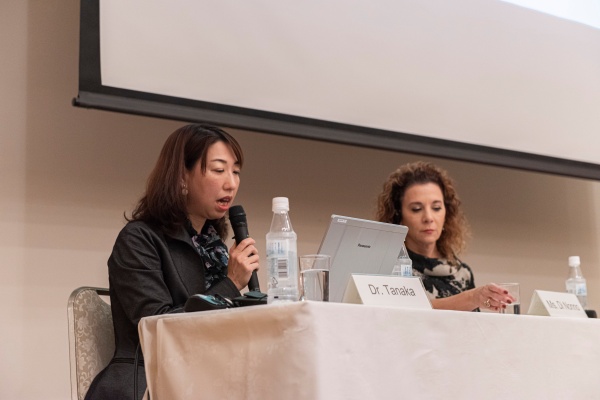 Dr. Tohko Tanaka
Dr. Tohko Tanaka
She said that the keynote address was delivered under a new concept of “intersectionality” like this, and verifies it as proven data. Looking back on the situations in Japan, Japan is more than 20 years behind in its approach to the theme of “gender and intersectionality” in media. Regarding why the existing media in Japan lack gender perspectives, Dr. Tanaka cited three factors: (1) Problem of gender structure of people engaged in media industries – what adverse effects are being caused in Japanese media culture where not only “intersectionality” but even “gender equality” has not been achieved; (2) The gap between contents made by media producers and women who receive them comes up to the surface through SNS; and (3) During the period from 2015 to 2019, many women responded with sharp criticism to the representations of women in advertisements of local governments and corporate enterprises.
As a result, advertisements that emphasize stereotyped gender roles as well as those that are suggestive of the commercialization of women, and videos and posters using adult video methods are released one after another. It happens repeatedly that they come under fire one after another and get withdrawn, but soon, new ones appear. Dr. Tanaka pointed out that not only private companies but also highly public organizations like local governments and universities tend to produce such PR videos.
As a new direction, Dr. Tanaka said that, responding to the “#metoo” movement, #kutoo” is spreading and protest against rules that force women to wear pumps at the workplace has begun, and concluded her presentation with a prediction that such movements will spread widely in the future.
Following Dr. Tanaka, “UN Communications and Gender Equality” by Ms. Kaoru Nemoto (Director, United Nations Information Centre) began with the introduction of the United Nations Information Centre. The centre is under the direct control of the UN Headquarters in New York, and it has been serving as a bridge between Japan and the United Nations since its establishment in 1958.
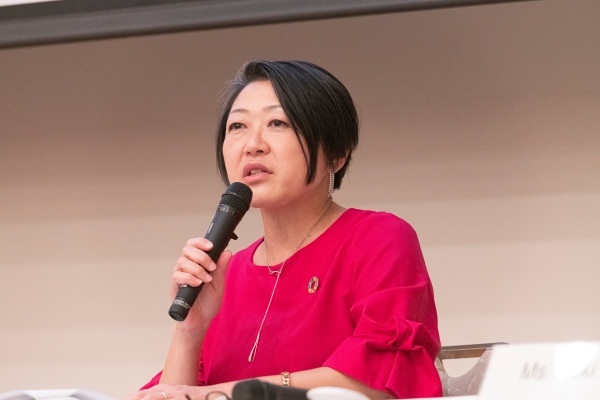 Ms. Kaoru Nemoto
Ms. Kaoru Nemoto
The United Nations is promoting the “Sustainable Development Goals (SDGs)” set as an action plan for “Transforming our world: the 2030 Agenda for Sustainable Development” adopted as an outcome document of the “United Nations Sustainable Development Summit” (held in 2015 at the UN Headquarters in New York). The SDGs consisting of 17 goals and 169 targets aim to promote three aspects – economic growth, social inclusion, and environmental protection – in an integrated fashion, and Ms. Nemoto emphasizes that the promotion of gender equality, which is one of the cross-sectoral issues, is an important factor in achieving the series of goals.
Four years have passed since the adoption of the SDGs. Checking on the progress of the 5th goal – gender equality, while a degree of progress has been made in women’s participation in politics, a mountain of problems still remain such as violence against women and child marriage. In order to eliminate unconscious gender bias that still remains deeply rooted in society, education from an early age is the key. During the presentation, Ms. Nemoto showed a video in which female characters specially created by the United Nations in popular Thomas the Tank Engine teach children about the SDGs and gender equality in plain words as a part of an outreach program for preschool children.
The last report was “Women’s Empowerment Through Media” by Ms. Reiko Aoki (Visiting Researcher, Information Division, National Women’s Education Center).
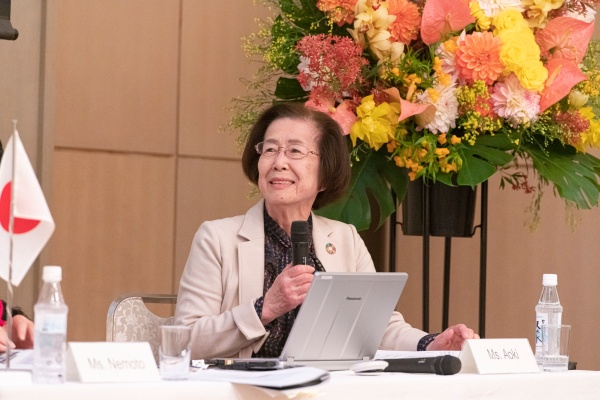 Ms. Reiko Aoki
Ms. Reiko Aoki
Recently, the Great Hanshin-Awaji Earthquake Memorial “Disaster Reduction and Human Renovation Institution” and many other museums, monuments and memorial halls have been built. But, Ms. Aoki questioned whether women’s records such as truth teller projects and experience sections are kept there, and followed the energetic activities women engaged in after the disaster. PhotoVoice Project, which was set up after the Great East Japan Earthquake, supports activities of women affected by the Earthquake to record and disseminate disaster experiences through photos and “voices (messages)” from various perspectives for the purpose of achieving locally-driven recovery. They disseminate disaster experiences through exhibitions and Internet. Participants bring photos and talk about them in groups. Through discussions, they gain a deeper understanding about their own perspectives as well as perspectives of people around them, and issues of local community as well as those of the entire society. Also, as another effort to scoop up voices of disaster-affected women, Ms. Aoki introduced the lecture “My stories told through embroidery – Memories of the Great East Japan Earthquake” organized by NPO Equal Net Sendai.
Since women’s activities to record disasters have significant meaning in supporting empowerment of women who experienced disasters, Ms. Aoki proposes that it is urgently needed that those who have no means to raise voices get together to unearth various community and social issues, share them, empower each other, and disseminate them to reach solution.
Toward the realization of a sustainable media system, she emphasized the following six aspects to conclude the presentation:
(1) Importance of experiences of disaster victims;
(2) Consideration to diverse people;
(3) Importance of incorporating gender perspectives into reconstruction/disaster prevention policies;
(4) Visualization of disaster process;
(5) Promotion of gender equality in peacetime forms the foundation for disaster prevention and reconstruction;
(6) Cooperation with mass media and action groups that have gender perspectives.
It turned out to be an energetic seminar where participants engaged in lively discussions to grasp the new concept of “intersectionality” multidirectionally.
Seminar Handouts
International Cooperation
- International Seminar
- FY2019 Seminar for Gender Equality Officers and Women Leaders in the Asia Region
- FY2018 Seminar for Gender Equality Officers and Women Leaders in the Asia Region
- FY2017 Seminar for Gender Equality Officers and Women Leaders in the Asia Region
- FY2016 Seminar for Gender Equality Officers and Women Leaders in the Asia Region
- FY2015 Seminar for Gender Equality Officers and Women Leaders in the Asia Pacific Region
- FY2014 Seminar for Gender Equality Officers and Women Leaders in the Asia Pacific Region
- FY2013 Seminar for Gender Equality Officers and Women Leaders in the Asia Pacific Region
- FY2012 Seminar for Gender Equality Officers and Women Leaders in the Asia Pacific Region
- FY2011 Seminar for Gender Equality Officer and Women Leaders in the Asia Pacific Region
- FY2010 Empowerment Seminar for Women Leaders in the Asia Pacific Region
- FY2009 Empowerment Seminar for Women Leaders in the Asia Pacific Region Final Report
- FY2008 Empowerment Seminar for Women Leaders in the Asia Pacific Region
- FY2007 Empowerment Seminar for Women Leaders in the Asia Pacific Region
- FY2006 Empowerment Seminar for Women Leaders in the Asia Pacific Region
- NWEC Global Seminar
- FY2025 NWEC Global Seminar: Addressing Technology-Facilitated Gender Based Violence (TFGBV): Approaches to Eradicate the Invisible Harm
- FY2024 NWEC Global Seminar: Gender Equality and Care
- FY2023 NWEC Global Seminar: Gender Mainstreaming & Strengthening Institutional Mechanism with Gender Perspective
- FY2022 NWEC Global Seminar: Does Digital Technology Advance Gender Equality?
- FY2021 NWEC Global Seminar: Combating Gender-Based Violence – “Building Back Better” from the Covid-19 Crisis
- FY2020 NWEC Global Seminar: Covid-19 and Gender
- FY2019 NWEC Global Seminar: Gender and Media
- FY2018 NWEC Global Seminar: Promotion of the Advancement of Women - What Japan can learn from Iceland about Gender Equality?
- FY2017 NWEC Global Seminar: Promotion for Advancement of Women Lessons from Germany
- FY2016 NWEC Global Seminar: Promotion for Advancement of Women –Lessons from Europe
- FY2015 International Symposium: Gender Equality and Women's Empowerment
- FY2014 International Symposium: Keys to Diversity and Women's Leadership
- FY2013 NWEC International Symposium:Gender Equality for Men
- FY2012 NWEC International Symposium:To Make a Society without Violence against Women a Reality
- FY2011 NWEC International Symposium
- FY2010 International Forum for Women's Empowerment
- FY2009 International Forum for Women's Empowerment
- FY2008 International Forum for Women's Empowerment Final Report3
- FY2008 International Forum for Women's Empowerment Final Report2
- FY2008 International Forum for Women's Empowerment Final Report1
- Cooperation with JICA
- FY2024 Knowledge Co-Creation Program on "Promotion of Global Networking on Anti-Trafficking in Persons"
- FY2024 Knowledge Co-Creation Program "Eradicating Sexual and Gender-Based Violence (SGBV)"
- FY2023 Knowledge Co-creation Program "Promotion of Networking among ASEAN Countries on Anti-Trafficking in Persons”
- FY2023 Knowledge Co-Creation Program "Eradicating Sexual and Gender-Based Violence (SGBV)"
- FY2022 Knowledge Co-creation Program "Promotion of Networking among ASEAN Countries on Anti-Trafficking in Persons”
- FY2022 Knowledge Co-Creation Program "Eradicating Sexual and Gender-Based Violence (SGBV)"
- FY2021 Knowledge Co-creation Program "Promotion of Networking among ASEAN Countries on Anti-Trafficking in Persons”
- FY2020 Knowledge Co-creation Program "Promotion of Networking among ASEAN Countries on Anti-Trafficking in Persons”
- FY2019 Knowledge Co-creation Program "Promotion of Networking among ASEAN Countries on Anti-Trafficking in Persons”
- FY2018 Knowledge Co-creation Program "Promotion of Networking among ASEAN Countries on Anti-Trafficking in Persons”
- Issue-specific Training “Seminar on Promotiom of Networking among ASEAN Countries on Anti-Trafficking in Persons”
- Basic Information-Gathering Survey/Workshop Seminar on the Economic Independence for Women in Central America and the Caribbean (El Salvador/Dominican Republic)
- Regional Gender Seminar in Central and South America
- 2015 Issue-specific Training "Seminar on Promotion of Networking among Asian Countries on Anti-Trafficking in Persons"
- Seminar on the Promotion of Education for Girls and Women II
- International Conference/International Exchange
- Online meeting with Seisen International School elementary students
- Visitor: Mansfield Fellows
- Visitor:JICA Knowledge Co-Creation Program (KCCP) on "Women's Empowerment through Business for Central American Integration System (SICA) Member Countries"
- The 68th Session of the Commission on the Status of Women
- Visitor: Madam Sustjie Mbumba, First Lady of the Republic of Namibia
- Workshop of commemorating the donation of the Beate Shirota Gordon archive materials
- Meeting with Korean Women’s Development Institute (KWDI)
- The Coalition of Finnish Women's Associations (NYTKIS) Secretary General Ms. KAKKOLA’s Courtesy Call to Foreign Minister KAMIKAWA
- The Coalition of Finnish Women's Associations (NYTKIS) Secretary General Ms. KAKKOLA’s Japan Visit Program
- The 67th Session of the Commission on the Status of Women
- NGO CSW67 Forum
- Webinar with Korean Women’s Development Institute (KWDI)
- The 66th Session of the Commission on the Status of Women (Hybrid format)
- Online meeting with international graduate students from the Appropriate Technology course at the University of Tsukuba
- The 65th session of the Commission on the Status of Women
- Lecture "The Beate Sirota Gordon Archives at Mills College"
- Participation in 2nd AGenT
- The 64th session of the Commission on the Status of Women
- Dr. Wang from National Taiwan University visits NWEC
- Japan Network of Women Engineers and Scientists and The Japan Inter-Society Liaison Association Committee for Promoting Equal Participation of Men and Women in Science and Engineering: 9th Japan Korea China Women Leaders Forum for Science & Technology
- Researcher from the KWDI visits NWEC
- Visit by a delegation from the Socialist Republic of Vietnam Ministry of National Defense
- Briefing on the Reykjavik Index for Leadership
- Women's Archives Center Exhibition "Beate Sirota Gordon and gender equality in Japanese Constitution"
- Visit from the Guangxi Women’s Federation
- Participation in the 63rd Session of the Commission on the Status of Women
- 7th Global Forum on Gender Statistics
- FY2018 International Symposium hosted by Korean Institute for Gender Equality Promotion and Education “Gender Equality at Schools”
- Visit from All-China Women’s Federation(ACWF)
- Participation in the 62nd Session of the Commission on the Status of Women
- The 14th KIGEPE International Symposium “Empowering Women’s Leadership: expanding influence and innovation”
- Participation in the 61st Session of the Commission on the Status of Women
- Visit from the Batis Center for Women
- 2011 Asia Women Eco-Science Forum (a forum of science and engineering leaders in Japan, China and Korea)
- The 60th Session of the Commission on the Status of Women
- The 59th Session of the United Nations Commission on the Status of Women
- The 58th Commission on the Status of Women
- The 57th Session of the United Nations Commission on the Status of Women
- International Symposium: Gender Awareness Education for Sustainable Development
- Thirtieth Anniversary Programs
- Attendance at the Ceremony Commemorating the 25th Anniversary of the Korean Women’s Development Institute (KWDI)
- Japanese-Filipino children (JFC)* from the Philippines-based NGO “DAWN” visit the Center
- Visitors from Abroad to NWEC
- Research report on Multicultural Family Support in South Korea
- Workshop on Gender and Education: Life-long Learning for Women’s Empowerment
- Lecture Delivered by a Visiting Researcher
- Connections: Bringing Together the Next Generation of Women Leaders in Science, Technology, Engineering and Mathematics
- Conclusion of Memorandum of Understanding on Exchange and Cooperation with the Ministry of Women's Affairs, Royal Government of Cambodia
- Visit to Japan by the Minister of Women’s Affairs of the Royal Government of Cambodia
- KIGEPE Delegation Visit
- Officials of Ministry of Information and Communications of the Socialist Republic of Vietnam visited NWEC
- The 56th Commission on the Status of Women
- Dr. Barker's visit
- Multidisciplinary Intellectual Exchange for Women Leaders from the United States, Japan, South Korea and the Philippines
- Courtesy visit to University of Hawai`i
- Delegation of Board for the Advancement of Women, Ministry of Finance of the Socialist Republic of Vietnam visited NWEC
- Visit Korean Women's Development Institute (KWDI)
- Report on Participation in the 5th World Social Forum on Migration
- A group led by the Vice President of the Korean Women's Development Institute visited NWEC
- A disaster management specialist from India visits the Center
- Visit to the Korean Institute for Gender Equality Promotion & Education (KIGEPE) and others
- Secretary of State, Ministry of Justice, Kingdom of Cambodia visited NWEC
- Research conducted in the Republic of the Philippines
- Research on the Comparative Study of the Gender Equality Policy in Southeast Asian Countries in the Kingdom of Cambodia
- Ochanomizu University and A Canadian Women’s Study Researcher visited NWEC
- Aigyung Yang, Research Fellow and Former Director of Strategy Board for Women Friendly Policies of the Korean Women's Development Institute (KWDI) Visits NWEC
- Delegation of the Ministry of Defense of the Socialist Republic of Vietnam visited NWEC
- Delegation from the Women and Development Center, of the Vietnam Women's Union, Visited NWEC
- The "7th Asia-Pacific Forum on Development and Gender" was held in Seoul, South Korea
- HOME
- International Cooperation
- NWEC Global Seminar
- NWEC Global Seminar
- FY2019 NWEC Global Seminar: Gender and Media

